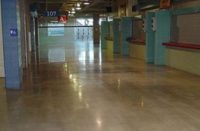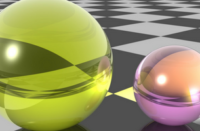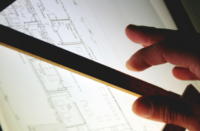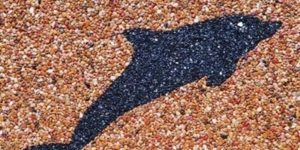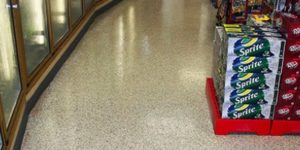
Dull, gray, utilitarian. Decorative concrete contractors discarded those descriptions of concrete a long time ago, producing a dizzying number of colors and designs.
What some contractors may not have considered is producing unusual colors using colored aggregate — either as part of the concrete mix or through various exposed-aggregate techniques. A soft champagne pink? Glittery blue? Bright white? All these colors, and more, are possible by taking advantage of the various shapes, colors and characteristics of aggregate unique to different parts of the country.
When working with exposed aggregate, contractors can use a standard concrete mix or find special aggregate with unusual colors or shapes. It can be broadcast on the surface of the concrete. However, the trick is to make sure it’s installed to the right depth and that it’s scattered evenly. If it’s not deep enough, the aggregate can break loose from the slab; too deep, and too little is exposed.
 Colorful aggregate can make the difference between boring and brilliant. Bart Sacco’s Concrete Texturing Tool & Supply, located inside a newly built, gated castle in Throop, Penn., near Scranton, shows the range of possibilities available with aggregate. On one floor, Sacco used a concrete mix from Masters Ready Mix Concrete that contained a local blue aggregate, cured it for 28 days under burlap, and a few days later, ground and polished it. “When I poured the floor, I also put glass in it to bring another dimension to it,” Sacco says. White and black pigments and chopped mirror were also used. “It looks dynamite,” he says. On another floor in his training center, he used white glass, black smelter glass, and green and black pigments and created a deep emerald green underfoot.
Colorful aggregate can make the difference between boring and brilliant. Bart Sacco’s Concrete Texturing Tool & Supply, located inside a newly built, gated castle in Throop, Penn., near Scranton, shows the range of possibilities available with aggregate. On one floor, Sacco used a concrete mix from Masters Ready Mix Concrete that contained a local blue aggregate, cured it for 28 days under burlap, and a few days later, ground and polished it. “When I poured the floor, I also put glass in it to bring another dimension to it,” Sacco says. White and black pigments and chopped mirror were also used. “It looks dynamite,” he says. On another floor in his training center, he used white glass, black smelter glass, and green and black pigments and created a deep emerald green underfoot.
The look of terrazzo
Terr-Con, manufactured by LPL Enterprises of Rochester, N.Y., is a specialty flooring system that combines two age-old products, concrete and terrazzo, incorporating colorful aggregate, glass chips, metal pieces, mother of pearl and more into a six-inch structural slab. Jason Bye of Rochester-based Floored LLC, a national distributor for Terr-Con, says the system was created by partners with extensive background in terrazzo, flatwork and concrete mix design, but it still took more than three years of practice on garage floors to perfect their product. One of the real challenges was to ensure a consistent placement of the aggregate to avoid the “spotty” look that inexperienced contractors can get. Getting the aggregate into the concrete at the appropriate time is another trick.
 “We like to get close to a terrazzo look, but it’s more durable than terrazzo due to the RetroPlate finish, and the big advantage is we’re about half the cost of terrazzo,” Bye says. RetroPlate, a diamond grinding and polishing system developed by Advanced Floor Products of Provo, Utah, eliminates the need for any sealers, lowering maintenance costs tremendously.
“We like to get close to a terrazzo look, but it’s more durable than terrazzo due to the RetroPlate finish, and the big advantage is we’re about half the cost of terrazzo,” Bye says. RetroPlate, a diamond grinding and polishing system developed by Advanced Floor Products of Provo, Utah, eliminates the need for any sealers, lowering maintenance costs tremendously.
Terr-Con, which is not a topping but an integral part of the slab, is popular in high-traffic areas. These areas include hospital lobbies and school hallways and cafeterias, Bye says. The company has covered more than half a million square feet for just one grocery store client.
Aggregate so bright you gotta wear shades
Aggregates offered by White Stone Calcium Inc., based in Chewelah, Wash., have also been used with great success for flooring in retail environments. In particular, one white rock is so bright that it actually lowered lighting costs for three grocery stores in Washington, says General Manager Russ Wilcox. He says piles of the white rock at the quarry are so bright, you need to wear sunglasses “or else you’ll get a blinding headache. You wouldn’t want to go in there with a hangover.”

White Stone Calcium produces 12 colors of marble, granite and quartzite. Additionally, jet black, valley rose, salt and pepper, buckskin and china white are among their offerings.
Nature has produced a range of colors in Wilcox’s backyard. A large deposit of dolomite with few impurities formed the bright white rock. A vein of iron impurities in another area created a rose-colored aggregate. Both of these feature large crystals that reflect light.
White Stone Calcium’s specialty aggregates are also used for terrazzo flooring and in exposed aggregate precast buildings. Nike sought out the clean, white look for an office building in Oregon. The Beaverton City Library, also in Oregon, uses the buckskin-colored aggregate, which is very hard and resists scratches.
Because there is no reactivity in the aggregate, acid etching does not change the colors, Wilcox says. Sandblasting or admixtures enhance them.
East Coast colors
On the other side of the country in northeastern Pennsylvania, a blue-gray sandstone is a popular aggregate. Robert Housel, of Masters Ready Mix Concrete, says the blue stone is softer than some, but it’s being shipped all over. One contractor in Chicago ordered two dump trucks hauled out there. “He liked the color so much, he had to have it.” In northern New York, a sparkly black and white granite is available. A hard stone, it works well for concrete. “Hardness and durability of the particles are the key things we look for,” Housel says.

Aggregate color and quality can vary dramatically in a small area. Bart Sacco says that a gray stone can be found on the east side of the Poconos Mountains, where he lives; on the other side, there are tans, pinks and some browns. From the base of the mountains comes a soft yellow aggregate used for fireplaces and storefronts. The glittery blue stone he used on his business floor is found about 20 miles north.
Contractors are also seeding recycled glass and even seashells into their decorative concrete projects. Some are using colored aggregates to inlay graphic designs into driveways, pool decks and more.
Aggregate suppliers can tell you about stone that is unique to their part of the country. The color of natural aggregates varies widely depending on the geologic features of the area. Try a dark granite from Minnesota, a pink quartzite from South Dakota or a golden-colored aggregate from Virginia. Everything from a delicate rose quartz to a rich black basalt is available. The possibilities are limitless.
Questions from Readers
Question
I’m getting ready to replace my 4,200-foot, 40+ year-old asphalt driveway with concrete. I’m going with an old school plain finish, however I want a bit of curb appeal. My goal is to purchase my concrete from the local company that sells the whitest mix and add a sand aggregate that will add a subtle “glitter” effect in the sun. Rose or gold/brown would be preferred. Is this finish even possible?
I remember as a young kid in the ’60s seeing some poured concrete that I thought had diamonds in it when reflecting in the sun. Any advice on technique or mixing ideas would help.
Answer from Concrete Decor
It sounds like a pretty fun project that you have in front of you.
While we can’t say much about your source for cement, as most ready-mix producers sell gray concrete, to get your ready-mix supplier to lighten your mix design you’ll have to talk with them about their available sources and capabilities.
It is possible to lighten the color of your concrete with a percentage of white cement (option: Lehigh Cement) along with the color of sand and aggregates. Another alternative is glass pozzolan. Up to 30 percent of the portland cement can be replaced with pozzolan which also yields a stronger mix as well. There are two sources for glass pozzolan that we can recommend, Vitro Minerals and Poraver. Check with either of them for the exact ratios.
As for that glitter effect we would encourage you to call Tom Ralston (a good friend of Concrete Decor) in Santa Cruz, California. He will be your best source for a product to achieve that sparkle you desire (Sparkle Grain.)
